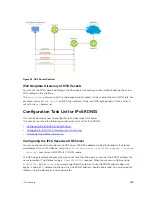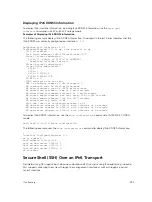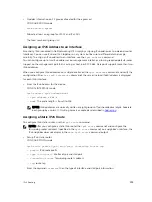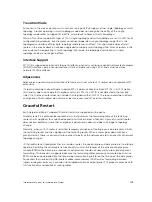
22
Intermediate System to Intermediate
System
Intermediate system to intermediate system (Is-IS) is supported on Dell Networking OS.
• IS-IS is supported on the Z9000 with Dell Networking OS 9.0(0.0).
•
• The IS-IS protocol is an interior gateway protocol (IGP) that uses a shortest-path-first algorithm. Dell
Networking supports both IPv4 and IPv6 versions of IS-IS.
• The IS-IS protocol standards are listed in the
IS-IS Protocol Overview
The IS-IS protocol, developed by the International Organization for Standardization (ISO), is an interior
gateway protocol (IGP) that uses a shortest-path-first algorithm.
NOTE: This protocol supports routers passing both IP and OSI traffic, though the Dell Networking
implementation supports only IP traffic.
IS-IS is organized hierarchically into routing domains and each router or system resides in at least one
area. In IS-IS, routers are designated as Level 1, Level 2 or Level 1-2 systems. Level 1 routers only route
traffic within an area, while Level 2 routers route traffic between areas. At its most basic, Level 1 systems
route traffic within the area and any traffic destined for outside the area is sent to a Level 1-2 system.
Level 2 systems manage destination paths for external routers. Only Level 2 routers can exchange data
packets or routing information directly with external routers located outside of the routing domains. Level
1-2 systems manage both inter-area and intra-area traffic by maintaining two separate link databases;
one for Level 1 routes and one for Level 2 routes. A Level 1-2 router does not advertise Level 2 routes to a
Level 1 router.
To establish adjacencies, each IS-IS router sends different protocol data units (PDU). For IP traffic, the IP
addressing information is included in the IS-IS hello PDUs and the link state PDUs (LSPs).
This brief overview is not intended to provide a complete understanding of IS-IS; for that, consult the
documents listed in
IS-IS Addressing
IS-IS PDUs require ISO-style addressing called network entity title (NET).
For those familiar with name-to-network service mapping point (NSAP) addresses, the composition of
the NET is identical to an NSAP address, except the last byte is always 0. The NET is composed of the IS-
IS area address, system ID, and N-selector. The last byte is the N-selector. All routers within an area have
the same area portion. Level 1 routers route based on the system address portion of the address, while
the Level 2 routers route based on the area address.
Intermediate System to Intermediate System
401
Summary of Contents for Z9000
Page 1: ...Dell Configuration Guide for the Z9000 System 9 7 0 0 ...
Page 80: ...grub reboot 80 Management ...
Page 128: ... 0 Te 1 1 Te 1 2 rx Flow N A N A 128 Access Control Lists ACLs ...
Page 491: ...Figure 70 Configuring OSPF and BGP for MSDP Multicast Source Discovery Protocol MSDP 491 ...
Page 496: ...Figure 73 MSDP Default Peer Scenario 1 496 Multicast Source Discovery Protocol MSDP ...
Page 497: ...Figure 74 MSDP Default Peer Scenario 2 Multicast Source Discovery Protocol MSDP 497 ...
Page 498: ...Figure 75 MSDP Default Peer Scenario 3 498 Multicast Source Discovery Protocol MSDP ...
Page 760: ...Figure 100 Single and Double Tag TPID Match 760 Service Provider Bridging ...
Page 761: ...Figure 101 Single and Double Tag First byte TPID Match Service Provider Bridging 761 ...
















































